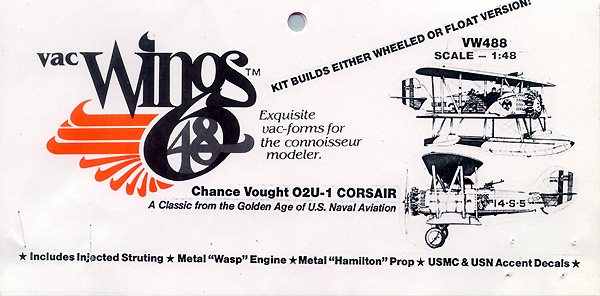
|
KIT: |
Wings 1/48 Vought O2U 'Corsair' |
|
KIT # |
VW 488 |
|
PRICE: |
$19l95 |
|
DECALS: |
Two aircraft |
|
REVIEW & |
|
|
NOTES: |
Kit vacuform with white metal |

|
HISTORY |
Dubbed the “Corsair” by it’s designer, Chance M. Vought, the O2U and it’s derivatives were US naval aviation’s most widely used bi-plane aircraft during the “Golden Age” between 1927 and 1940. The design was basically an upgrade of the company’s UO/FU series, incorporating an all-steel tubular fuselage and a Pratt & Whitney Wasp engine. It had interchangeable float or wheeled landing gear and could carry a crew of two armed with up to three .30 cal Lewis machine guns (two firing forward mounted atop the top wing, and one on a flexible mount facing to the rear). 50lb bombs could be carried under the wings, and later variants could loft a 500lb bomb under the centerline.
Deliveries started in 1927 and continued until 1933, when the type was replaced in front line service by the O3U (basically a developed version of the O2U-4). In service, it replaced all previous types aboard surface combatants and was the first production aircraft to serve off the first carriers, USS Langley, Saratoga and Lexington. It was also used by USMC units, notably in combat in 1928 against Nicaraguan bandits. Some examples remained in service with the Coast Guard, training establishment, and reserves until 1942.
|
THE KIT |
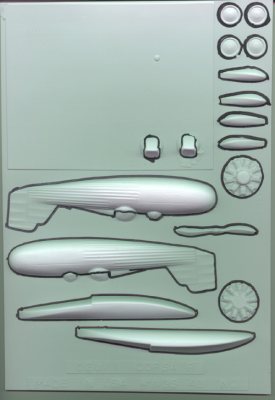 |
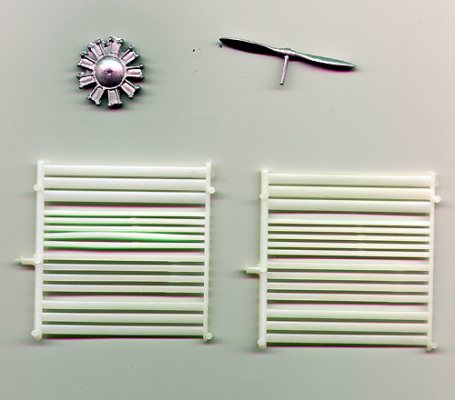 |
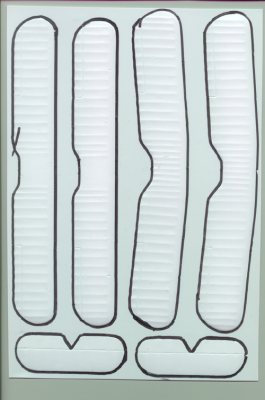 |
Here’s another subject we’re unlikely to see in a state-of-the-art injection molded kit (having said that, Hasegawa will no doubt release one within the year). Inside the bag you get:
Two sheets of .040” styrene containing major components
One bag of styrene struts/braces
White metal engine and prop by Aeroclub
Two small sheets of decals, by Microscale
Three sheets of instructions with marking guide (sort of)
The parts and instructions are sufficient to build a USN or USMC O2U-1, with or without floats, though some bits will have to be scratch built or found from other sources. With some additional work, one can build any O2U mark (there were 4) or a Nakajima Type 90 E4N1.
The styrene parts provide fuselage, wing, float, stabilizer and wheel halves, plus seats and faintly inscribed templates for the various struts. Panel lines are finely and consistently engraved; other surface details are equally nice, though the ribbing effect of the fabric covered fuselage looks a bit too prominent to my eyes.
The white metal engine and prop replace vacuformed pieces. Made by Aeroclub, they are cleanly cast and nicely detailed, though the engine will need push rods and ignition harnesses to look the most convincing. Two “frets” of white plastic struts are also provided. These are airfoil-shaped in various widths.
What you get enables the modeler to build the basic assemblies. However, details – such as everything in the crew area, the Lewis guns, tail skid, etc. must be scratch built or raided from the spares box.
The instructions, such as they are, consist of historical information and some text outlining a plan of attack for construction. They obviously assume that only an experienced builder will be tackling this kit, so more is not necessarily necessary. Drawings are provided for each version showing where the bits go in a general sense. Text describing the unique attributes of each aircraft for which decals are provided are also included. There is also a drawing showing the four versions of the O2U, plus a side view of the E4N1.
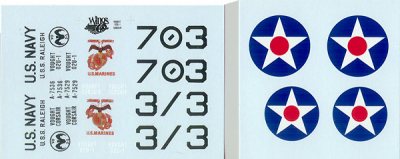 Decals
are provided for two aircraft.
Decals
are provided for two aircraft.
USN O2U-1 of VO-3S, aboard USS Raleigh in 1928. This
was the 9th production machine.
USMC O2U-1, one of two flown by 1stLt Christian Schilt fighting Nicaraguan
bandits in 1928 (for which he was awarded the Medal of Honor)
Printed by Microscale, they’re perfectly registered and appear to be in correct colors.
|
CONCLUSIONS |
The kit provides all the basics for replicating an important piece of US naval aviation history. With the amount of details that will need to be scratch built or raided from the spares box, it’s obviously not for the novice builder. However, those with the experience and the interest will find it a nice addition to the flight line – and for sure, it’ll stand out amongst the fleets of Me-109s and Fw-190s at any contest.
The kit is available directly from Wings 48, 3349
Wildridge Dr, NE, Grand Rapids, MI 49505, USA.
Make checks payable to the owner, Don Bratt.
If you would like your product reviewed fairly and quickly by a site that has thousands of visits a day, please contact me or see other details in the Note to Contributors.